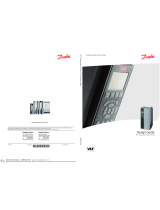
•
•
•
Value depending on feature
(vibration, load envelope, stator winding)
Frequency Maximum
e30bi292.10
N O T I C E
For new installations, ISO 20816 recommends a wear-in period before taking a baseline measurement.
2.4.2 Step 2: Sensor Conguration (Optional)
Vibration monitoring requires installation of an external vibration transmitter. The sensor is connected via analog input using for
example terminal 53 or terminal 54. When using these terminals make sure to scale correctly. For AI53 S201 to ON = mA and for AI54
switch S202 to ON = mA.
Make sure to congure the correct scaling using parameters in Parameter Group 6-1* Analog Input 1.
For example when terminal AI53 is used, congure the following:
Parameter 6-12 Terminal 53 Low Current
Parameter 6-13 High Current
If these terminals are in use for other equipment, it is possible to extend the analog input with extension options. For information on
extension options, see the Selection Guide.
2.4.3 Step 3: Threshold Calculation
Dening or setting the threshold values
In this step, the thresholds are dened. There are 3 methods of threshold calculation.
Absolute: This is the common method when the equipment values are already known. The threshold has a xed value irrespec-
tive of the measured baseline value. For example, when the operator knows the absolute limit for the equipment, an absolute
value is set for the alarm threshold. In case of vibration monitoring, the limit values described in standards such as ISO
10816/20816 can be used for the alarm threshold as an absolute value.
Oset: This method of setting threshold values requires understanding of the application and baseline values. The threshold
depends on the baseline value to which a user-dened oset is considered in the threshold conguration. Setting a very low or
high value leading to false positives is a risk when using this method. False settings can cause irresponsive monitoring, even in
the case of faults.
Factor: This method is easier to use when compared to oset, because it does not require in-depth application knowledge. The
threshold depends on the baseline value which is multiplied by a factor. For example, the threshold value may be 150% of the
baseline. Setting a very high threshold is a risk when using this method of threshold calculation.
2.4.4 Step 4: Alarms and Warnings
In condition-based monitoring, for each feature, the user can dene activation stages for warnings and alarms. The interpretation of
alarm and warning color codes are as follows:
Green: No alarms are indicated. Condition-based monitoring operations continue.
Yellow: First indication of warning-stage 1 alarm is visible. Stage 1 warning fault are also shown as Stage 1 Warning (S1). Notication
to users to plan for maintenance operations. In this stage, condition-based monitoring operations continue.
Orange: Clear indication of warning-stage 2 alarm is visible. Stage 2 warning fault are also shown as Stage 2 Warning (S2). Notica-
tion to users to act as soon as possible before the fault becomes critical.
Red: A critical alarm has occurred and condition-based monitoring operations has stopped.
AU310741645108en-000201 / 130R0901 | 13Danfoss A/S © 2020.10
Introduction to Condition-based
monitoring
VLT® Condition-based Monitoring
Programming Guide




















